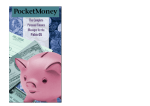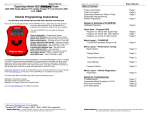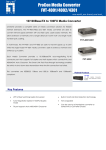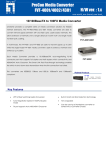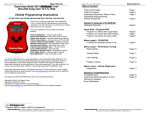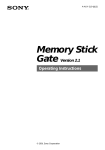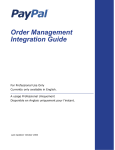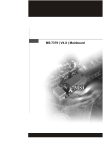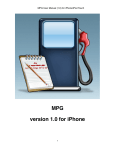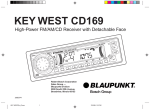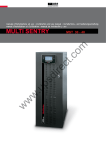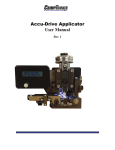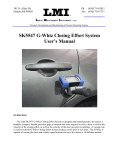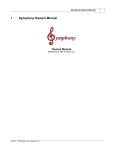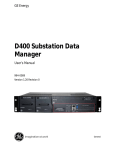Download MPG for Palm OS User Manual
Transcript
MPG Users’ Manual Copyright MPG User’s Manual ©1996-2000 Catamount Software. All rights reserved. Contact Information US Mail: Phone: email: www: Catamount Software PO Box 8276 Essex,VT 05451, USA (802) 372-9512 [email protected] http://www.catamount.com Trademarks MPG™ is a trademark of Catamount Software. PocketMoney® is a registered trademark of Catamount Software. Other product names mentioned in this manual may be trademarks or registered trademarks of their respective companies and are the sole property of their respective manufacturers. MPG Users’ Manual License Agreement 1. License. The application, demonstration, system and other software accompanying this License, whether on disk, in read-only memory, or by any other media (the “Software”) and the related documentation are licensed to you by Catamount Software. You own the media on which the Software is recorded but Catamount Software and/or Catamount Software’s Licenser(s) retain title to the Software and related documentation. This License allows you to use the Software on a single Palm Computing Device, and make one copy of the Software in machine-readable form for backup purposes only. You must reproduce on such copy Catamount Software’s copyright notice and any other proprietary legends that were on the original copy of the Software. You may also transfer all your license rights in the Software, the backup copy of the Software, the related documentation and a copy of this License to another party, provided the other party reads and agrees to accept the terms and conditions of this License. 2. Restrictions. The Software contains copyrighted material, trade secrets and other proprietary material and in order to protect them, you may not decompile, reverse engineer, disassemble or otherwise reduce the Software to a human-per-ceivable form. You may not modify, network, rent, lease, loan, distribute or create derivative works based upon the Software in whole or in part. 3. Termination. This License is effective until terminated. You may terminate this License at any time by destroying the Software and related documentation. This License will terminate immediately without notice from Catamount Software if you fail to comply with any provision of this License. Upon termination you must destroy the Software and related documentation. 4. Export Law Assurances. You agree and certify that neither the Software nor any other technical data received from Catamount Software, nor the direct product thereof, will be exported outside the United States except as authorized and as permitted by the laws and regulations of the United States. If the Software has been rightfully obtained by you outside of the United States, you agree that you will not re-export the Software nor any other technical data received from Catamount Software, nor the direct product thereof, except as permitted by the laws and regulations of the United States and the laws and regulations of the jurisdiction in which you obtained the Software. 5. Government End Users. If you are acquiring the Software on behalf of any unit or agency of the United States Government, the following provisions apply. The Government agrees: (i) if the Software is supplied to the Department of Defense (DoD), the Software is classified as “Commercial Computer Software” and the Government is acquiring only “restricted rights” in the Software and its documentation as that term is defined in Clause 252.227-7013(c)(1) of the DFARS; and (ii) if the Software is supplied to any unit or agency of the United States Government other than the DoD, the Government’s rights in the Software and its documentation will be as defined in Clause 52.227-19(c)(2) of the FAR or, in the case of NASA, in Clause 18-52.227-86(d) of the NASA Supplement to the FAR. 6. Disclaimer of Warranty on Software. You expressly acknowledge and agree that use of the Software is at your sole risk. The Software and related documentation are provided “AS IS” and without warranty of any kind and Catamount Software and Catamount Software’s Licenser(s) (for the purposes of provisions 6, Catamount Software and Catamount Software’s Licenser(s) shall be collectively referred to as “Catamount Software”) EXPRESSLY DISCLAIM ALL WARRANTIES, EXPRESS OR IMPLIED, INCLUDING, BUT NOT LIMITED TO, THE IMPLIED WARRANTIES OF MERCHANTABILITY AND FITNESS FOR A PARTICULAR PURPOSE. Catamount Software DOES NOT WARRANT THAT THE FUNCTIONS CONTAINED IN THE MPG Users’ Manual SOFTWARE WILL MEET YOUR REQUIREMENTS, OR THAT THE OPERATION OF THE SOFTWARE WILL BE UNINTERRUPTED OR ERROR-FREE, OR THAT DEFECTS IN THE SOFTWARE WILL BE CORRECTED. FURTHERMORE, Catamount Software DOES NOT WARRANT OR MAKE ANY REPRESENTATIONS REGARDING THE USE OR THE RESULTS OF THE USE OF THE SOFTWARE OR RELATED DOCUMENTATION IN TERMS OF THEIR CORRECTNESS, ACCURACY, RELIABILITY, OR OTHERWISE. NO ORAL OR WRITTEN INFORMATION OR ADVICE GIVEN BY Catamount Software OR AN AUTHORIZED REPRESENTATIVE OF Catamount Software SHALL CREATE A WARRANTY OR IN ANY WAY INCREASE THE SCOPE OF THIS WARRANTY. SHOULD THE SOFTWARE PROVE DEFECTIVE,YOU (AND NOT Catamount Software OR AN AUTHORIZED REPRESENTATIVE OF Catamount Software) ASSUME THE ENTIRE COST OF ALL NECESSARY SERVICING, REPAIR OR CORRECTION. SOME JURISDICTIONS DO NOT ALLOW THE EXCLUSION IF IMPLIED WARRANTIES, SO THE ABOVE EXCLUSION MAY NOT APPLY TO YOU. 7. Limitation of Liability.UNDER NO CIRCUMSTANCES INCLUDING NEGLIGENCE, SHALL Catamount Software BE LIABLE FOR ANY INCIDENTAL, SPECIAL OR CONSEQUENTIAL DAMAGES THAT RESULT FROM THE USE OR INABILITY TO USE THE SOFTWARE OR RELATED DOCUMENTATION, EVEN IF Catamount Software OR AN AUTHORIZED REPRESENTATIVE OF Catamount Software HAS BEEN ADVISED OF THE POSSIBILITY OF SUCH DAMAGES. SOME JURISDICTIONS DO NOT ALLOW THE LIMITATION OR EXCLUSION OF LIABILITY FOR INCIDENTAL OR CONSEQUENTIAL DAMAGES SO THE ABOVE LIMITATION OR EXCLUSION MAY NOT APPLY TO YOU. In no event shall Catamount Software’s total liability to you for all damages, losses, and causes of action (whether in contract, tort (including negligence) or otherwise) exceed the amount paid by you for the Software. 8. Controlling Law and Severability. This License shall be governed by and construed in accordance with the laws of the United States and the State of Vermont, as applied to agreements entered into and to be performed entirely within Vermont between Vermont residents. If for any reason a court of competent jurisdiction finds any provision of this License, or portion thereof, to be unenforceable, that provision of the License shall be enforced to the maximum extent permissible so as to effect the intent of the parties, and the remainder of this License shall continue in full force and effect. 9. Complete Agreement. This License constitutes the entire agreement between the parties with respect to the use of the Software and related documentation, and supersedes all prior or contemporaneous understandings or agreements, written or oral, regarding such subject matter. No amendment to or modification of this License will be binding unless in writing and signed by a duly authorized representative of Catamount Software. MPG Users’ Manual Table of Contents 1 . I n t ro d u c t i o n----------------------------------------------------- 1 Know your Palm OS Device.......................................................... 1 Purchasing MPG........................................................................... 2 Registering MPG.......................................................................... 2 2 . B a s i c s ------------------------------------------------------------- 3 Vehicles List Screen .................................................................... 3 Record Types ............................................................................... 4 Data Entry Screen ........................................................................4 The Vehicle Log Screen................................................................ 9 Menus ........................................................................................ 10 View....................................................................................10 Options................................................................................ 11 Tools.................................................................................... 11 Record..................................................................................12 Edit..................................................................................... 12 3 . F e a t u re s--------------------------------------------------------- 13 List Editor..................................................................................13 Preferences ................................................................................ 14 Vehicle Info............................................................................... 15 Creating an Vehicle............................................................. 16 Deleting an Vehicle............................................................. 16 Custom Filters ........................................................................... 16 Multiple Users: IR Sync Option................................................... 18 All Vehicles........................................................................ 18 Selected Vehicles.................................................................19 Selected Records...................................................................19 One Record........................................................................... 19 MPG Users’ Manual 4.InterfacingMPG w i t h D e s k t o p A p p l i c a t i o n s --------------------------------21 Installing Macintosh Conduit..................................................... 21 Installing Windows Conduit....................................................... 21 Import and Export Formats ......................................................... 22 Tab-delimited Format (TDF)................................................ 22 Conduit Settings........................................................................ 22 Exchanging Data....................................................................... 24 Upload from Palm to Desktop............................................... 24 Download from Desktop to Palm........................................... 24 MPG Users’ Manual 1 1. Introduction MPG is a log book for your car. MPG replaces the little notepad in your glovebox with an intelligent tracker. MPG tracks fuel, oil changes, tune-ups, inspections, tire rotations, windshield wipers, car washes trips, and other miscellaneous expenses for your car. It generates statistics such as average miles per gallons, total cost of gas, and average price of gas. Fuel economy is calculated for the fuel entries. Time, distance and time per distance are calculated for trips. Trip reports can be generate for tax purposes. MPG reduces redunant data entry by integrating with PocketMoney, a personal finance program also by Catamount Software. Know your Palm OS Device This manual assumes that you are already familiar with basic Palm OS operation including: • Writing and editing. • Launching applications. • The Up and Down scroll buttons. • Installling Software on your Palm device. If not, consult your Palm Computing Device User Manual before you proceed. MPG Users’ Manual 2 Purchasing MPG There are several ways to purchase MPG. • Credit Card Online - Kagi processes credit card payments for Catamount Software. Goto <http://order.kagi.com/?HM> if you have a credit card and wish to pay online. This is typically the fastest way to pay for the software. It still takes a few days for me to turn around your registration code. • Cash - I’ll accept cash payments in any currency that is equivalent to the current price of MPG. Send to address below. • Checks/Cheques - I can only accept US checks and Canadian cheques. Canadian cheques need to take into account the current exchange rates. • International Postal Orders - I can accept IPOs. Mail payments to: Catamount Software PO Box 8276 Essex VT 05451, USA Registering MPG The registration code is based on your device’s hotsync name. This is mostly likely your name. I will email a code to you. Enter it in the Registration Code field on the About Screen accessed from the Options menu. MPG Users’ Manual 3 2. Basics This chapter covers basic MPG transaction operations and screens. Refer to “Features” for full coverage of all of MPG’s features. Vehicles List Screen You may create as manyvehicles as needed in the Vehicle List screen by tapping the New button (See Vehicle Prefs” for more information). • Vehicle Info Button - opens the Vehicle Info Screen. • New Vehicle - button creates a new vehicle. Accessing a particular Vehicle Log To access the corresponding Register from the Vehicle Screen, simply tap the desired vehicle name. Vehicle Info Button Vehicle Name MPG Users’ Manual 4 Record Types MPG provides three types of transactions using the Data Entry Slip: • Fuel - used whenever you add gasoline or other forms of fuel to your vehicle. Tracks the fuel economy. • Service - used when you change your oil, tune up the vehicle, or other miscellaneous expenses to the car. • Trip - used to track distance and time traveled for business purposes, measurement purposes, or to track your average speed on long trips. Data Entry Screen The Data Entry Screen looks similar to this for Fuel, Service, and Trip records: Tips Record Type Date/Time Account/Payment Type Location Odometer Trip Mileage Amount Cost per Gal or Litre Gallons or Litres Octane Fuel economy Save Folder Don't Save Delete Memo/Notes Post to PocketMoney It includes the following elements: • Folder - the folder that the current transaction is filed in. By default, this is “Unfiled”. • Record Type - either Fuel, Service, or Trip. • Date/Time - the date & time that the transaction took place. Tap on the date or time to popup change the date/time. Transactions are listed by Date, so by modifying the date/time you can reorder the way checks are MPG Users’ Manual 5 listed. • Payment - the name of the account that you paid for service with (e.g., checking, Visa, or any other one that you have created). Tap on the Payment picker to select an account for the transaction. If PocketMoney is installed and you have Use PocketMoney turned on in the Prefs then the popup will list your PocketMoney accounts. Hint: You can use folders to keep your personal expenses separate from your business expenses for expense reporting. • Location - the place the fillup or service was rendered or the location of where you are at during your trip. Write or key in a name or tap on the Location to select a location for the record or to access the List Editor. • Odometer- the current mileage. • T- the trip mileage. If you enter the trip mileage MPG will calculate the odometer based on the last recorded entered of this type. Hint: Activate “Auto-add to popups” in Prefs to save time editing the popup list. • Amount - the amount of the fillup/service/toll. • Memo/Notes/Description - Several lines of additional information of your choice about the transaction. • Post To PocketMoney - Tap the $ to post this transaction to PocketMoney. With just one tap you can save a lot of duplicate data entry. Fuel Extras • Cost/Gal or Cost/L- the price per gallon (or price per Litre if you have a non-US Unit selected in the Vehicle Prefs). When entered the Gallons are calculated by dividing the Amount by the Cost/Gal. MPG Users’ Manual 6 • Gallons or Litres- the number of gallons (or Litres depending on the Unit selected in the Vehicle Prefs). When entered the Cost/Gal is calculated by dividing the Amount by the Gallons. • Gas Can - the partial fillup gas can toggles between full and partial in order to correctly calculate the fuel economy. If you fill up your tank then the gas can should be set to full. If you do not completely fill up your tank then set the gas can to partial. • Octane - the octane of the fuel being used. • mpg - the fuel economy in miles per gallons (or L/100km depending on the Unit selected in the Vehicle Prefs). Service Extras • Service - the service performed such as oil changes. You can also use this for miscellaneous costs such as speeding tickets! Trip Extras • Purpose - nature of the trip. Used for the statistics to generate how many miles you used your vehicle for a specific purpose. The main use for this field is to allow you to categorize trips for tax purposes. • Trip Point - location in trip. All trips must have a Start Trip and End Trip point. Trip Point’s popup menu is based on the last trip entry, depending on what your last trip entry was the popup will change accordingly. Start Trip - When you start a trip you set trip point to Start Trip. Pause Trip - This allows you to take breaks in a trip. It can be used for pit stops or meetings with clients. Time and distance are ignored for mph and distance calculations during a pause/resume trip entries. Resume Trip - The companion of Pause Trip is resume. When you start MPG Users’ Manual 7 traveling again enter a new Resume trip entry. Distance Markers - Used for measuring out directions. It gives you a good way to enter landmarks if you are giving directions. If I’m using MPG to record directions I would start trip, distance marker (turn right), distance marker (turn left at 3rd light), ..., end trip. End Trip- When you end a trip you set trip point to End Trip. • Time - The time elapsed since the start of the trip. (Does not include the time wasted in the Pause/Resume pit stops.) • mph - Miles per hour is calculated since the last trip point. The average mph can be more useful than just a fancy fact...the next time a cop pulls you over you can show the officer that you have only been averaging 65 miles per hour since mile marker 23 which was 15 miles back. I haven’t had to try this yet, but if MPG gets anyone out of a ticket because of this I would like to know about it and possibly receive a big Christmas present for the money that MPG just saved you. ;-) Trip Example Question from user: “Maybe it's just me, but I can't seem to figure out how the Trip screen works. Do you create one for the start and one for the end? What info goes into the cost? Could you give me an example so I might understand it.” Answer: You need to create one entry for the start of the trip and one for the end of the trip. The majority of the time you will not enter anything into the cost field, but I left the cost field there because once in a while I will enter the amount I pay for tolls in the trip section. An example would be (I'm at home, go to work, and return home): 1. I'm at home and I get into my vehicle.While I'm waiting for my vehicle to warm up I add a new trip item. Tap New and tap Trip. a. The record defaults to start trip - unless you have a start trip entered without a corresponding end trip in which case it will default to end trip. b. Thepayment method will be blank - most of the time you will not be entering a cost, hence no payment method. c. Enter "Home" for the location. You can either write it into the location field or if it is a common starting or end point then you can add it to the MPG Users’ Manual 8 popup list. d. Enter the odometer. e. If I know the route to work Iwill be taking I enter the route into the notes field. Most of the time I leavethis blank until I am actually taking the route I think I will be taking. I also might enter weather conditions and traffic conditions. (rain/heavy traffic/accident) 2.When I arrive at work I enter the end trip. Tap New and tap Trip. a. The record shoulddefault to End Trip because Start Trip was the last trip item entered. b. Enter "Work" for the location. c. Enter the odometer. (If you know the trip distance then you can enter the distance in the “T:” field and the odometer will be updated.) 3. I'm at work or a job site and now I must enter a new trip to continue on. The easiest way to do this to avoid duplicate data entry is to choose "Duplicate" from the Record Menu. a. The record should default to Start Trip because End Trip was the last trip. b. The location will still be "Work" c. The odometer will still be the same MPG Users’ Manual 9 The Vehicle Log Screen The Log screen provides a list of records. Vehicle Name Folder Column Headings Records Return to Vehicle List Scroller New Record • Vehicle Name - the name of the vehicle that you are viewing. This will be set to “All Vehicles” if you have choosen “All Records” in the View Menu or you set Vehicle to “All Vehicles” in a Custom Filter. • Middle Column Heading - the middle column ( Odo/Service) can display different fields of the transactions. [Memo, Odometer, Odo/Service, Pay/Loc, Service, Vehicle/Odo, Vehicle/Service]. • Right Column Heading - the righ column ( Amount) can display the Amount or the Fuel Economy. By displaying fuel economy you can catch trends of your fuel economy dropping which might mean it is time for a tune-up . • New - tap this button to create new transaction. • OK - tap this button to return to the Vehicle List Screen. Accessing a particular Data Entry Slip Tap the desired record to access the corresponding Data Entry Slip. MPG Users’ Manual 10 Menus Tap the Menu button to access the menus in MPG. Depending on what screen you are in will determine what menu is displayed. View • All Records - displays all of the records regardless of the vehicle. • Create Custom Filter... - opens the Custom Filter Screen in order to create a new filter. (See “Custom Filters” for futher information). • Select Custom Filter... - popups a list of custom filters that have been saved in the Custom Filter Screen. • Transaction at Date- pops up a date picker and displays records starting at the selected date in the log. • First Transaction - moves to the first record. (Same as moving the scroll bar to the very top.) • Last Transaction- moves to the last record. (Same as moving the scroll bar to the very bottom.) • New Transaction- creates a New record and opens the Edit Record window. MPG Users’ Manual 11 Options • IR Sync - beam transactions to MPG on another Palm. (See “HotSync Scenarios” for further information). • Preferences - opens the MPG Preferences screen, allowing you to change the default behavior of some features. (See “Preferences” for further information). • About - displays a screen with the version of MPG and technical support contact information. Tools • General Statistics - generates a report of vehicle expenses and fuel economy. • Trip Statistics - generates a trip report summarized by trip purpose. • Last Service - generates a report of the last mileage and date a service was performed on the vehicle. • Delete Records... - deletes all of the records in the currently found set. Use the Custom Filter option to select a range of records. MPG Users’ Manual 12 Record • New - creates a new record. • Duplicate - makes a copy of the current record on the Data Entry Slip into a new record. The date will be set to the present date & time. If the record type is Trip then the trip purpose might be changed to reflect the next logic trip point. • Beam - beams record to MPG on another Palm device. Edit The Edit menu consists of your standard Palm OS Edit menu. Any screen that has an input area for text will have the Edit menu available. MPG Users’ Manual 13 3. Features Chapters 2 and 3 covered basic transaction entry and navigation. This chapter covers all the other features of MPG. List Editor The editor is how you edit MPG customizable popup lists. Lists that are editable are: Categories, Payees, ID#s, Amounts, Currency Prefix, and Currency Suffix. Use the List Editor as follows: • Select Edit in the popup list to bring up the List Editor so that you may add, rename or remove list items. • To Add an Item to the List,tap New. • To Rename an Item, select the item you wish to rename and tap the Rename button. Enter the new name. • To Remove an Item from the List, select the item, and tap Delete. MPG Users’ Manual 14 Preferences The MPG Preferences screen is accessed from the Options menu : It includes the following items: • Auto-add to popups - determines the behavior of the popups automatically. Check the check box to add any new location, payment, octance, service, or trip purpose to their popup lists. • Hide ListView Scrollbar - hides the scroll bar in the log view. This speeds up the display. You can scroll the log view with the up and down buttons whether or not the scroll bar is displayed. • Fillup decimal places - specifies the number of decimal places to use for theprice per gallon. • Use PocketMoney-FPS - actives the MPG’s use of PocketMoney accounts for payments and allows posting of the financial transactions to PocketMoney • Confirm posts to PocketMoney - always display the PocketMoney Edit Transaction window so you can review the transaction being saved to PocketMoney. • Post in category - the PocketMoney category to save the transaction under. MPG Users’ Manual 15 Vehicle Info The Vehicle Prefs screen allows you to supply detailed information about particular vehicles and set default values and behaviors for those vehcicles. It includes the following data items: • Vehicle - name as appears in the Vehicle lists. Write in the name of the new vehicle. • Units - determines what units to input and how fuel economy is calculated. • Mileage -is a reference for you only. Enter the number of miles on the car when you bought it. A new car would be zero and a used car be be 32,328. MPG does not use Starting Mieage for any computations, yet. • VIN- acronym for Vehicle Identification Number, for reference. • Plate # - license plate number, for reference. • Engine Size- size of engine, for reference. • Notes - general notes, for reference. MPG Users’ Manual 16 Creating a New Vehicle From the Vehicle List screen tap . This opens a new Vehicle Info screen for you to name and enter the details for the new vehicle. Deleting an Vehicle Tap to delete all information for the displayed vehicle. MPG asks you to confirm the deletion. The Delete button is located on the Vehicle Information screen. Note: Deleting the vehicle deletes all records associated with that vehicle. Custom Filters Filters are a powerful way to display and report on subsets of records. MPG dynamically updates the views of the data represented by the currently chosen filter every time the screen is redrawn. From the Log screen tap Menu and select Create Custom Filter from the View menu or write . Pick which items you would like displayed: • Vehicle - allows selection of particular vehicle or All Vehicles to include in the filter. Tap the Vehicle and select the desired vehicle. • Type - allows selection of Fuel, Service, Trip, or All Records to include in the filter. Tap the Account and select the desired record type. Depending on the Type other Filter options will be available. MPG Users’ Manual 17 Fuel: Filter on Octane. Service: Filter on Service. Trip: Filter on Purpose. • Payment - allows selection of particular payment to include in the filter. Tap the Payment select tap the desired payment. • Location - allows selection of particular location to include in the filter. Tap the Location and select or write in the desired item. • (Dates) From - allows selection of a start date to include in the filter. Tap the From to bring up the Date Editor. • (Dates ) To - allows selection of ending date to include in the filter. Tap the To to bring up the Date Editor. Hint: Two special cases for Date To and Date From are: Today: If selected MPG will replace “Today” with the current date whenever the filter is evaluated. 1st of Month : If selected MPG will replace ““1st of Month” with the first day of the current month. For example, if today is May 12, 2000 then MPG will use May 1, 2000. • Recent - allows selection of records which have changed or were added since the last HotSync. Check the Recent checkbox to show only recent changes. Several buttons at the bottom of the filter screen determine the disposition of the filter conditions: • Tap Set to set the filter as defined in the Filter screen. • Tap Cancel to close the Filter Conditions screen and leave the filter unchanged. MPG Users’ Manual 18 • Tap Save to save the filter conditions with a name that you choose. That name now appears in the Custom Filter popup when you select the “Select Custom Filter...” option in the View menu. • Tap Remove... to delete a previously saved filter. Note: If you change a record value that does not conform to the current filter, the record will not appear in the Log Screen when you close the Data Entry Slip. Multiple Users: IR Sync Option If you and your spouse both use MPG then the IR Sync option is the preferred way to keep your vehicles in MPG in sync. All Vehicles If you and your spouse share multiple vehicles and must have MPG in sync on both Palms then MPG’s IR Sync option makes it easy. 1. Spouse #1 opens to the Vechile List screen. 2. Spouse #1 chooses IR Sync from the Options menu to beam unbeamed records to Spouse #2. 3. Spouse #2 accepts the incoming beam. 4. Spouse #2 performs steps 1 & 2. MPG Users’ Manual 19 Selected Vehicles If you and your spouse only share one vechile, but not your other vehicles then you need to do a couple extra steps. 1. Spouse #1 opens the vehicle log that you want to sync. 2. Spouse #1 chooses IR Sync from the Options menu to beam unbeamed records to Spouse #2. 3. Spouse #2 accepts the incoming beam. 4. Spouse #2 performs steps 1 & 2. 5. Repeat steps 1-4 for any of the other vehicles that you want in sync. Selected Records Sort of like Selected Vehicles, but with more control. Create a Custom Filter for only the data you want to exchange. Any data being viewed will be beamed. Follow steps in Selected Vehicles, but instead of opening athe vehicle log, you want to select the custom filter criteria. One Record Go to the record you wish to beam. Select Beam from the Record Menu. MPG Users’ Manual 20 MPG Users’ Manual 21 4. Interfacing MPG with Desktop Applications MPG supports importing and exporting of transactions via the MPG Conduit. There are Macintosh and Windows conduits for PocketMoney. Installing Macintosh Conduit 1. Copy “MPG Conduit” to the Conduits folder located in the Palm Desktop folder. 2. Hotsync so the MPG conduit can create the folders in your user directory. Installing Windows Conduit 1. Exit HotSync by clicking the HotSync icon in the System tray and select Exit. 2. Copy “MPGCOND.DLL” to the same directory that the HotSync application is in. (It is probably C:\Palm\ ). 3. If you have HotSync/PalmDesktop 3.0 installed then skip to step 5. 4. If you have HotSync 2.0 then copy "CONDMGR.DLL" to the HotSync directory. 5. Double click the MPGCOND.REG file. This adds necessary data to the Windows Registry for the MPG Conduit. 6. Run the HotSync application again. If everything installed correctly then you should see MPG in the custom settings listing. MPG Users’ Manual 22 7. Hotsync so the MPG conduit can create the directories in your user directory. Import and Export Formats Tab-delimited format (TDF) - standard format for interchanging data with databases and spreadsheets. Conduit Settings Access to the MPG Conduit Setting is different on the Macintosh and Windows platforms. Macintosh: Open the HotSync application, choose Conduit Settings from the HotSync menu, double click the MPG line to open the MPG Conduit Settings window. Windows: Click the HotSync button in the System Tray, select Custom, double click the MPG line to open the MPG Conduit Settings window. HotSync Direction • Update Handheld from Desktop - checking this will download “MPG.tdf” file located in the PocketMoney/ToPalm folder to MPG on the Palm. • Update Desktop from Handheld - checking this will upload data located from MPG on the Palm device to a file called “MPG.tdf” located in the MPG/FromPalm folder. • Upload All Transactions - checking this will upload all transactions from MPG, the current MPG.tdf file will be deleted before uploading the data. Leaving this unchecked will only upload transactions that have been changed since the last HotSync, the data will be appended to the current MPG.tdf file. MPG Users’ Manual 23 Date Format Choose the date format that of the data you will be importing and and the format you want to export you data as. MPG Users’ Manual 24 Exchanging Data Upload from Palm to Desktop: After you set all of the settings in the MPG Conduit Settings window then you can HotSync. When HotSync is completed a MPG.tdf file will be located in the FromPalm folder. Refer to the user manual of your desktop program for importing and exporting tab delimited text data. Downloading from Desktop to Palm: Export the data from your database or spreadsheet program. Move the file to the ToPalm folder. HotSync.






























